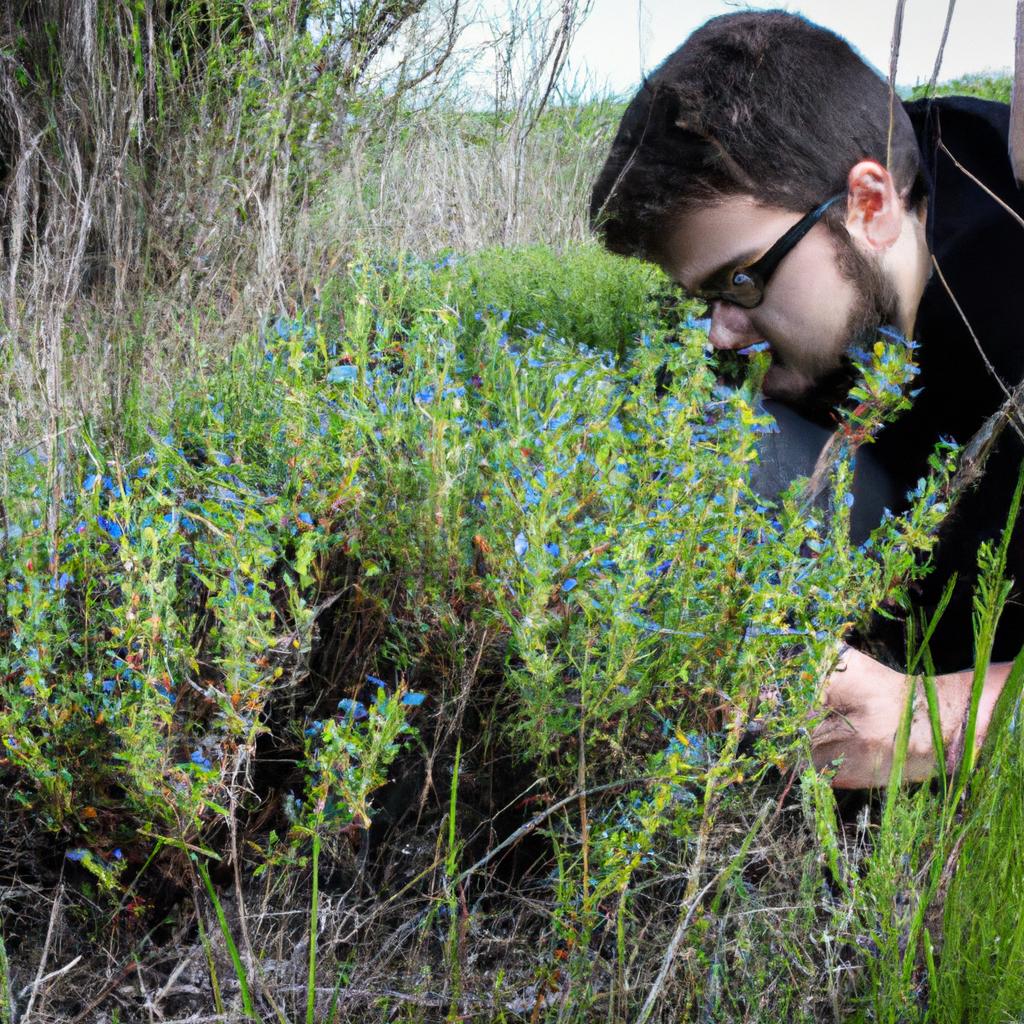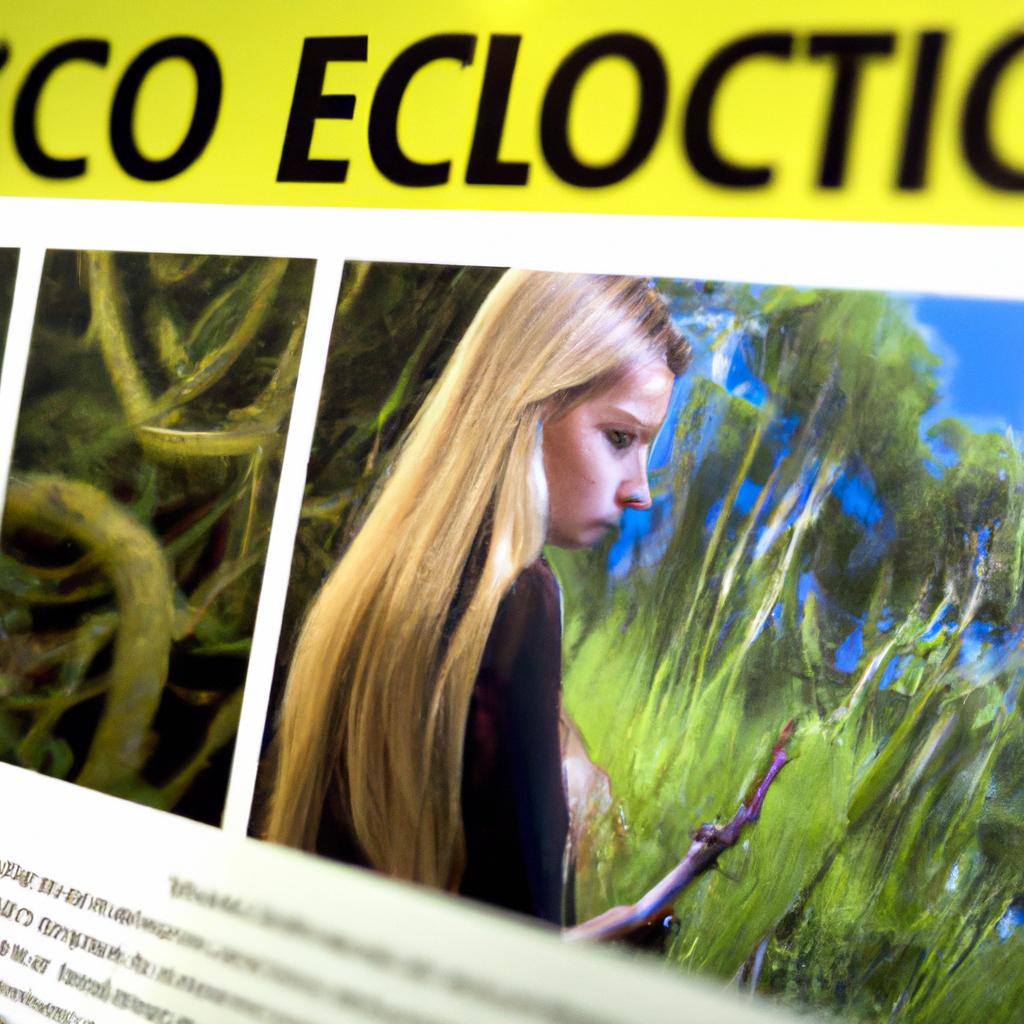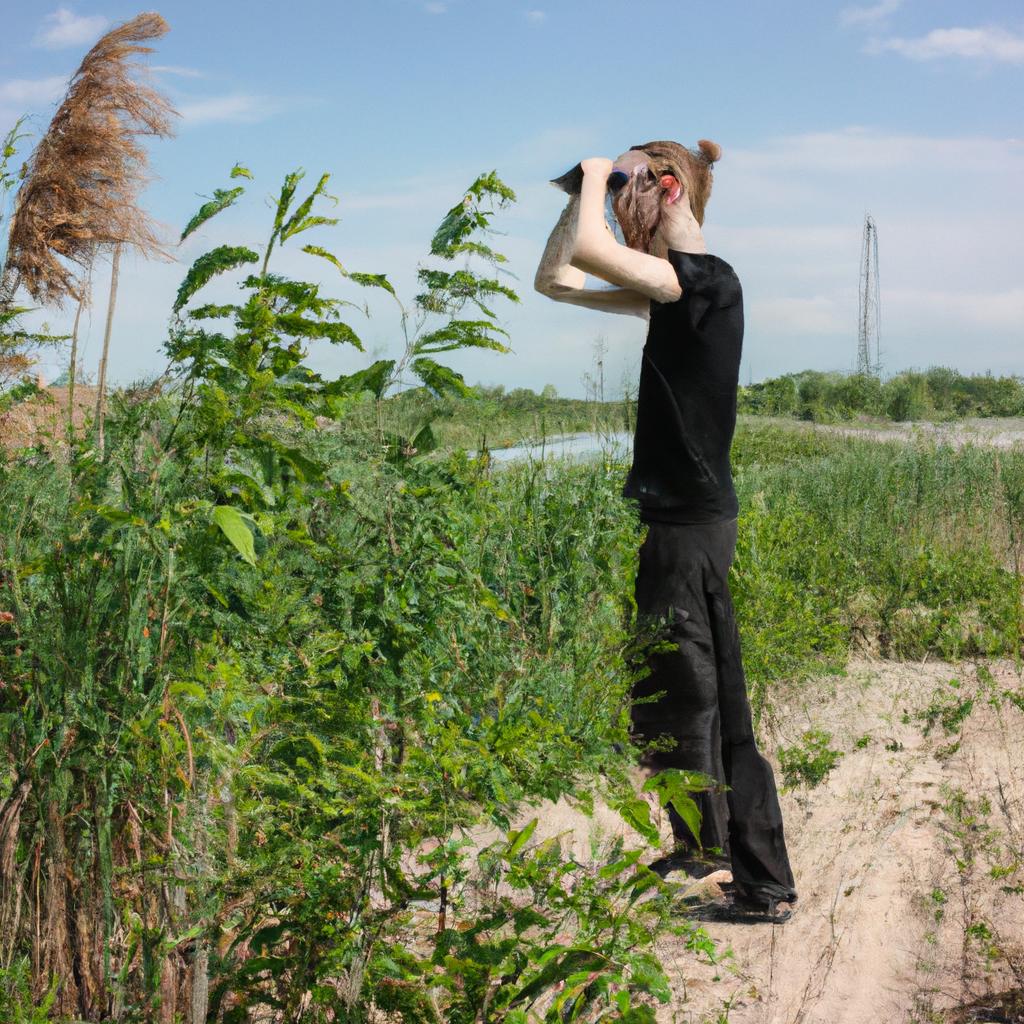Habitat Destruction: The Science Behind Ecology’s Detrimental Impact

Habitat destruction is a pressing issue that continues to pose significant threats to ecological systems worldwide. Its detrimental impact on the delicate balance of ecosystems has been well-documented and studied by scientists across various disciplines. One illustrative example of habitat destruction’s consequences can be observed in the case study of the Amazon rainforest, where deforestation activities have led to severe disruptions in species composition and overall ecosystem functioning.
The science behind habitat destruction unveils a complex web of interconnections between organisms and their environment, revealing how human-induced alterations can disrupt long-established ecological processes. It encompasses a range of destructive practices such as deforestation, urbanization, pollution, and climate change, all contributing to the loss or degradation of critical habitats for countless plant and animal species. Understanding these underlying mechanisms is crucial for comprehending the far-reaching consequences that follow, including biodiversity loss, disruption of biogeochemical cycles, altered nutrient dynamics, changes in water availability, and increased vulnerability to invasive species. By exploring the scientific foundations behind habitat destruction, we gain valuable insights into its wide-ranging impacts on both local and global scales while recognizing our collective responsibility for conservation efforts.
Understanding habitat destruction
Understanding Habitat Destruction
Habitat destruction is a pressing issue with far-reaching implications for the delicate balance of ecosystems. To grasp its significance, let us consider the hypothetical case study of the Amazon rainforest, often referred to as the “lungs of the Earth.” This vast and diverse habitat provides shelter to countless species, plays a crucial role in regulating global climate patterns, and serves as an invaluable source of medicinal plants.
Firstly, it is essential to recognize that habitat destruction encompasses various human activities such as deforestation, urbanization, pollution, and land conversion for agriculture or industrial purposes. These activities disrupt natural habitats by altering their physical and chemical characteristics. For instance, trees are felled in large numbers in the Amazon rainforest to make way for cattle ranching or soybean cultivation. Consequently, this leads to irreversible damage where once thriving forests dwindle into fragmented patches unable to support their intricate web of plant-animal interactions.
The consequences of habitat destruction extend beyond mere loss of biodiversity; they ripple through ecological systems impacting both flora and fauna. The interconnectedness within ecosystems becomes disrupted when key species lose their homes and food sources. A stark example is witnessed in pollinator decline due to habitat fragmentation — without sufficient floral resources over extended areas, bees struggle to survive leading to reduced crop yield globally.
To truly comprehend the gravity of these impacts on our planet’s fragile ecosystems, consider this emotional perspective:
- Species extinction: Each year sees numerous animal and plant species vanish from existence due to habitat destruction.
- Loss of cultural heritage: Indigenous communities relying on traditional knowledge rooted in specific habitats face displacement and erasure.
- Disruption of ecosystem services: Habitats provide critical services like water filtration, flood control, carbon sequestration – all now at risk.
- Climate change aggravation: Deforestation adds significantly to greenhouse gas emissions accelerating global warming.
Table 1 below highlights some alarming statistics related to habitat destruction across different regions:
| Region | Habitat Loss (in hectares) |
|---|---|
| Amazon Rainforest | 8,000,000 |
| Great Barrier Reef | 50% |
| African Savanna | 60% |
| Boreal Forest | 3,200,000 |
In summary, habitat destruction is a complex issue with dire consequences. As we delve deeper into exploring the causes of this phenomenon in the subsequent section, it becomes evident that urgent action is necessary to address and mitigate its effects on our planet’s delicate ecosystems.
Transitioning seamlessly into the next section about “The Causes of Habitat Destruction,” let us now examine how human activities drive this destructive force.
The causes of habitat destruction
Understanding the detrimental impact of habitat destruction is crucial in order to address and mitigate its consequences. This section will delve deeper into the causes behind this destructive phenomenon, shedding light on the various factors that contribute to habitat loss. By examining these causes, we can gain a better understanding of the complexity and urgency surrounding habitat conservation.
To illustrate the gravity of habitat destruction, let us consider a hypothetical case study involving a tropical rainforest ecosystem. Imagine an area rich in biodiversity, teeming with rare plant species, unique animal populations, and countless interconnected ecological relationships. However, due to unsustainable logging practices driven by economic interests, large swaths of this pristine rainforest are cleared indiscriminately for timber production. The once vibrant forest floor now lies bare and barren, devoid of life. This stark example highlights how human activities can irreversibly alter ecosystems if left unchecked.
The causes of habitat destruction are multifaceted and often intertwined. Here are some key factors contributing to this devastating phenomenon:
- Land conversion: The expansion of agriculture and urbanization necessitates clearing land for crop cultivation or infrastructure development.
- Deforestation: Logging operations aimed at extracting valuable timber products lead to widespread deforestation and degradation of natural habitats.
- Mining: Extractive industries exploit mineral resources through extensive excavation processes that often result in permanent damage to ecosystems.
- Climate change: Alterations in temperature patterns and precipitation levels can disrupt delicate ecological balances, driving certain species out of their preferred habitats.
To emphasize the magnitude of habitat destruction’s impact on our planet’s biodiversity, we present below a visual representation using a bullet point list followed by a table showcasing key statistics:
Key points highlighting the emotional toll caused by habitat destruction:
- Loss of vital habitats threatens numerous endangered species with extinction.
- Destruction of ecosystems disrupts intricate food chains and reduces overall ecosystem resilience.
- Communities reliant on intact habitats suffer social and economic repercussions.
- Habitat loss diminishes opportunities for scientific research and discovery.
| Key Statistics |
|---|
| Over 50% of Earth’s tropical forests have been destroyed. |
| Each year, approximately 18 million acres of forest are lost globally. |
| About one-third of reef-building corals worldwide are threatened with extinction. |
| The loss of habitat accounts for nearly half of the world’s known extinctions. |
Understanding these alarming figures and acknowledging the emotional impact they carry is crucial in motivating us to take action against habitat destruction.
In transitioning to our subsequent discussion on the effects of habitat destruction on biodiversity, we must recognize that addressing this issue requires urgent collective efforts from individuals, communities, governments, and organizations alike. By comprehending both the causes and consequences of habitat destruction, we can strive towards a future where ecological harmony is safeguarded for generations to come.
Effects of habitat destruction on biodiversity
Habitat Destruction: The Science Behind Ecology’s Detrimental Impact
Section H2: Effects of Habitat Destruction on Biodiversity
By unraveling complex ecosystems and disrupting natural processes, habitat destruction poses a significant threat to numerous species and their delicate interdependencies.
To illustrate the gravity of these effects, let us consider a hypothetical case study involving the conversion of a pristine forest into agricultural land. This transformation inevitably leads to the displacement or local extinction of various animal and plant species that rely on specific habitats within the forest ecosystem. For instance, an abundance of bird species may lose their nesting grounds, while mammals dependent on understory vegetation for shelter find themselves without suitable habitat. Consequently, disruption cascades through trophic levels as entire food webs are destabilized.
The consequences of such disruption extend beyond individual species. Here are some key impacts that arise from habitat destruction:
- Loss of genetic diversity: With shrinking habitats and isolated populations, genetic diversity diminishes, leaving species more susceptible to diseases and environmental changes.
- Increased competition among remaining species: As resources become scarce due to reduced availability and fragmentation, competition intensifies between surviving organisms.
- Disruption of pollination networks: Many plants rely on specific pollinators for reproduction. When habitats disappear or become fragmented, vital interactions between plants and their specialized pollinators break down.
- Decline in ecosystem resilience: Habitats act as buffers against disturbances by providing diverse niches for different organisms. The loss or degradation of these habitats reduces overall system resilience.
Table 1 below summarizes some notable examples showcasing how habitat destruction affects biodiversity across different ecosystems:
| Ecosystem | Example Species Affected | Impacts |
|---|---|---|
| Forest | Orangutans | Population decline due to habitat loss |
| Wetland | Amphibians | Loss of breeding sites and food sources |
| Coral Reef | Coral species | Reduced coral cover and biodiversity |
| Grassland | Prairie dogs | Disruption of burrowing ecosystem |
As we delve deeper into the intricate connections within ecosystems, it becomes evident that habitat destruction has far-reaching consequences beyond mere loss of individual species. To fully comprehend the magnitude of these effects, we must explore how this phenomenon shapes the provision of essential services by ecosystems in our subsequent section on “Impacts of Habitat Destruction on Ecosystem Services.”
Impacts of habitat destruction on ecosystem services
Section H2: Impacts of habitat destruction on ecosystem services
The detrimental effects of habitat destruction extend beyond the loss of biodiversity. This section will explore the impacts of habitat destruction on essential ecosystem services that are crucial for human well-being and global sustainability.
Example Scenario:
To illustrate the far-reaching consequences, consider a hypothetical case where extensive deforestation occurs in a tropical rainforest. As trees are cleared to make way for agricultural activities, various ecosystem services provided by this diverse biome undergo significant disruption.
Ecosystem Services Affected:
Habitat destruction leads to disruptions in several key ecosystem services, including:
- Climate Regulation: Forests play a vital role in regulating local and global climate patterns. The removal of trees disrupts this process as they act as carbon sinks, absorbing vast amounts of greenhouse gases from the atmosphere. Consequently, increased levels of carbon dioxide contribute to accelerated climate change.
- Water Purification: Forested areas act as natural filters, ensuring clean water supplies through processes such as precipitation interception and groundwater recharge. Without these ecosystems intact, sediments and pollutants can contaminate freshwater sources, compromising their quality.
- Soil Fertility: Habitats destroyed by human activities often result in soil degradation due to erosion and nutrient depletion. In our hypothetical scenario, deforestation would lead to decreased organic matter content and reduced fertility within the affected area.
- Pollination and Seed Dispersal: Many plant species rely on animals for pollination or seed dispersal. When habitats are destroyed, populations of pollinators like bees or birds decline significantly, jeopardizing the reproductive success of numerous plant species.
Table – Examples of Ecosystem Service Disruption:
| Ecosystem Service | Habitat Destruction Impact |
|---|---|
| Climate Regulation | Increased greenhouse gas emissions leading to climate change |
| Water Purification | Reduced water quality due to sedimentation and pollution |
| Soil Fertility | Decreased organic matter content and nutrient depletion |
| Pollination and Seed Dispersal | Decline in pollinator populations affecting plant reproduction |
Understanding the extensive impacts of habitat destruction on ecosystem services is crucial, as it highlights the interconnectedness between human activities and ecological well-being. In the subsequent section, we will delve into the role of human activities in driving such destructive processes.
The role of human activities in habitat destruction
Section H2: The Role of Human Activities in Habitat Destruction
The impacts of habitat destruction on ecosystem services are undeniable, but what factors contribute to this detrimental phenomenon? In order to fully understand the scope and magnitude of habitat destruction, it is essential to examine the role that human activities play. By exploring these human-driven causes, we can gain insight into how our actions directly influence the health and stability of ecosystems.
One example that highlights the destructive consequences of human activities is deforestation. Imagine a dense tropical rainforest teeming with biodiversity – home to countless species of plants and animals found nowhere else on Earth. Now picture large-scale logging operations moving into the area, clearing vast stretches of land for timber extraction or agricultural purposes such as palm oil plantations. This scenario represents just one manifestation of habitat destruction caused by human intervention.
To comprehend the breadth of human-induced habitat destruction, consider these key contributors:
- Urbanization: Rapid population growth often leads to increased urban development, resulting in the conversion of natural habitats into cities and suburbs.
- Agriculture: Expanding agricultural practices require extensive land clearance for crop cultivation and livestock grazing, displacing native flora and fauna.
- Industrialization: Industries reliant on raw materials extract resources from diverse ecosystems, disrupting their integrity.
- Infrastructure Development: Construction projects like roads, dams, and mining operations fragment habitats and disrupt ecological connectivity.
| Causes | Examples | Impacts |
|---|---|---|
| Urbanization | Conversion of forests into cities | Loss of wildlife habitat |
| Agriculture | Clearing land for agriculture | Displacement of indigenous species |
| Industrialization | Extraction industries damaging ecosystems | Pollution affecting water sources |
| Infrastructure Development | Building highways through forests | Fragmentation of habitats |
These examples illustrate some ways in which human activities lead to habitat destruction, ultimately jeopardizing ecosystem functioning and the services they provide. Recognizing our role in this process is crucial for developing effective strategies to mitigate and prevent further habitat loss.
Transitioning into the subsequent section on “Solutions to Mitigate Habitat Destruction,” it becomes evident that addressing this complex issue requires concerted effort from various stakeholders. By exploring potential solutions, we can begin to outline a path towards sustainable coexistence with nature, minimizing the negative impacts of human activities on habitats worldwide.
Solutions to mitigate habitat destruction
Habitat Destruction: The Science Behind Ecology’s Detrimental Impact
The Role of Human Activities in Habitat Destruction
As we have explored in the previous section, human activities play a significant role in habitat destruction. Now, let us delve deeper into the various ways through which these activities contribute to this detrimental phenomenon.
One striking example that highlights the consequences of habitat destruction is the deforestation occurring in the Amazon rainforest. This vast and diverse ecosystem has been under threat due to logging, agriculture expansion, and infrastructure development. Such activities lead to the fragmentation and degradation of habitats, disrupting intricate ecological processes and endangering numerous plant and animal species.
To better understand how human activities exacerbate habitat destruction, consider the following points:
- Urbanization: Rapid urbanization encroaches upon natural habitats, leading to their conversion for residential or commercial purposes.
- Industrialization: Industrial practices often result in pollution and contamination of ecosystems, rendering them unsuitable for many organisms.
- Agriculture: Extensive agricultural practices involve clearing large tracts of land for cultivation, causing loss of habitat for native flora and fauna.
- Extractive Industries: Mining operations can cause irreversible damage to ecosystems by destroying habitats and releasing harmful chemicals into surrounding areas.
| Destructive Activity | Ecological Consequences |
|---|---|
| Deforestation | Loss of tree cover |
| Pollution | Contamination of water |
| Overfishing | Decline in fish stocks |
| Land Conversion | Displacement of wildlife |
This table serves as a sobering reminder that every action humans take can have far-reaching implications for our environment. It emphasizes the importance of adopting sustainable practices to mitigate habitat destruction and preserve Earth’s delicate balance.
In light of these observations, it is imperative that we recognize the urgency of finding solutions to mitigate habitat destruction. By implementing measures such as reforestation programs, sustainable agricultural practices, and stricter regulations on industrial activities, we can strive towards restoring and preserving habitats for future generations.
Through a collective effort and a commitment to environmental stewardship, we have the power to reverse the devastating effects of habitat destruction and ensure a thriving planet for all its inhabitants. Let us act now before irreversible damage occurs.







